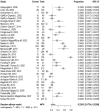The Prevalence, Etiological Agents, Clinical Features, Treatment, and Diagnosis of HIV-Associated Oral Candidiasis in Pediatrics Across the World: A Systematic Review and Meta-Analysis
- PMID: 35004551
- PMCID: PMC8740125
- DOI: 10.3389/fped.2021.805527
The Prevalence, Etiological Agents, Clinical Features, Treatment, and Diagnosis of HIV-Associated Oral Candidiasis in Pediatrics Across the World: A Systematic Review and Meta-Analysis
Abstract
In HIV-infected pediatrics, oral candidiasis (OC) is a global issue of concern due to its association with dysphagia, malnutrition, and mortality. The present systematic review and meta-analysis are the first to determine the prevalence of OC in HIV-infected pediatrics worldwide. We searched international (PubMed, Web of Science, Scopus, and Embase) databases for studies published between January 2000 to May 2020 reporting the epidemiologic features of OC in HIV-infected pediatrics. Inclusion and exclusion criteria were defined to select eligible studies. Data were extracted and presented according to PRISMA guidelines. The results of the meta-analysis were visualized as a forest plot. Heterogeneity was also analyzed using the I 2, and τ2 statistics. The publication bias was evaluated using Egger test. The literature search revealed 1926 studies, of which 34 studies met the eligibility criteria, consisting of 4,474 HIV-infected pediatrics from 12 different countries. The overall prevalence of OC among HIV-infected pediatrics was 23.9% (95% CI 17.3-32.0%), and Candida albicans was the most prevalent etiologic agent. Pseudomembranous candidiasis was the predominant clinical manifestation in HIV-infected pediatrics suffering from OC. Thirty articles involving 4,051 individuals provided data on HIV treatment status. Among the 4,051 individuals, 468 (11.53%) did not receive HIV treatment. The data from 11 articles demonstrated that HIV treatment was significantly associated with a reduction in oral Candida colonization or infection. In contrast, others showed the opposite relationship or did not report any statistical data. A high level of I 2 (I 2 = 96%, P < 0.01) and τ2 (τ2 = 1.36, P < 0.01) was obtained among studies, which provides evidence of notable heterogeneity between studies. OC is approximately frequent in HIV-positive children. Therefore, efforts should be made to teach dental and non-dental clinicians who care for HIV-infected pediatrics to diagnose and treat this infection.
Keywords: HIV; aids; children; infants; meta-analysis; oral candidiasis; pediatrics; prevalence.
Copyright © 2021 Rafat, Sasani, Salimi, Hajimohammadi, Shenagari and Roostaei.
Conflict of interest statement
The authors declare that the research was conducted in the absence of any commercial or financial relationships that could be construed as a potential conflict of interest.
Figures



Similar articles
-
Vulvovaginal candidiasis in Iran: A systematic review and meta-analysis on the epidemiology, clinical manifestations, demographic characteristics, risk factors, etiologic agents and laboratory diagnosis.Microb Pathog. 2021 May;154:104802. doi: 10.1016/j.micpath.2021.104802. Epub 2021 Mar 16. Microb Pathog. 2021. PMID: 33741400
-
Oral candidiasis among African human immunodeficiency virus-infected individuals: 10 years of systematic review and meta-analysis from sub-Saharan Africa.J Oral Microbiol. 2017 Jun 21;9(1):1317579. doi: 10.1080/20002297.2017.1317579. eCollection 2017. J Oral Microbiol. 2017. PMID: 28748027 Free PMC article. Review.
-
Prevalence of HIV-associated esophageal candidiasis in sub-Saharan Africa: a systematic review and meta-analysis.Trop Med Health. 2020 Sep 23;48:82. doi: 10.1186/s41182-020-00268-x. eCollection 2020. Trop Med Health. 2020. PMID: 32982560 Free PMC article. Review.
-
Beyond the black stump: rapid reviews of health research issues affecting regional, rural and remote Australia.Med J Aust. 2020 Dec;213 Suppl 11:S3-S32.e1. doi: 10.5694/mja2.50881. Med J Aust. 2020. PMID: 33314144
-
Candida coinfection among patients with pulmonary tuberculosis in Asia and Africa; A systematic review and meta-analysis of cross-sectional studies.Microb Pathog. 2020 Feb;139:103898. doi: 10.1016/j.micpath.2019.103898. Epub 2019 Nov 30. Microb Pathog. 2020. PMID: 31794817
Cited by
-
Recent advancements in 18F-FDG PET/CT for the diagnosis, staging, and treatment management of HIV-related lymphoma.Am J Nucl Med Mol Imaging. 2024 Apr 25;14(2):97-109. doi: 10.62347/QPAS5990. eCollection 2024. Am J Nucl Med Mol Imaging. 2024. PMID: 38737646 Free PMC article. Review.
-
Identification of fungal agents isolated from burn lesions using mycological and molecular methods in patients admitted to Velayat burn hospital in Rasht city during 2022-2023.Iran J Microbiol. 2024 Aug;16(4):490-496. doi: 10.18502/ijm.v16i4.16308. Iran J Microbiol. 2024. PMID: 39267924 Free PMC article.
-
Effect of the 1064 nm Nd: YAG Laser on the MICs of Antifungals Used in Clinical Practice for the Treatment of Fungal Nail Infections.J Lasers Med Sci. 2023 Sep 24;14:e35. doi: 10.34172/jlms.2023.35. eCollection 2023. J Lasers Med Sci. 2023. PMID: 38028881 Free PMC article.
-
Antifungal susceptibility profile of Candida species and uncommon yeasts from drug abusers with oral candidiasis.BMC Oral Health. 2024 Dec 26;24(1):1555. doi: 10.1186/s12903-024-05368-2. BMC Oral Health. 2024. PMID: 39725928 Free PMC article.
-
Oral Candidiasis in Adult and Pediatric Patients with COVID-19.Biomedicines. 2023 Mar 10;11(3):846. doi: 10.3390/biomedicines11030846. Biomedicines. 2023. PMID: 36979825 Free PMC article.
References
-
- Rafat Z, Hashemi SJ, Ashrafi K, Nikokar I, Jafari A, Foroushani AR, et al. . Fungal isolates of the respiratory tract in symptomatic patients hospitalized in pulmonary units: a mycological and molecular epidemiologic study. J Multidiscip Healthc. (2020) 13:661–9. 10.2147/JMDH.S252371 - DOI - PMC - PubMed
-
- Mensana MP, Ernawati DS, Nugraha AP, Soebadi B, Triyono EA, Husada D, et al. . Oral candidiasis profile of the Indonesian HIV-infected pediatric patients at UPIPI Dr. Soetomo General Hospital, Surabaya, Indonesia. HIV AIDS Rev. (2018) 17:272–7. 10.5114/hivar.2018.80259 - DOI
-
- Mushi MF, Bader O, Taverne-Ghadwal L, Bii C, Groß U, Mshana SE. Oral candidiasis among African human immunodeficiency virus-infected individuals: 10 years of systematic review and meta-analysis from sub-Saharan Africa. J Oral Microbiol. (2017) 9:1317579. 10.1080/20002297.2017.1317579 - DOI - PMC - PubMed
Publication types
LinkOut - more resources
Full Text Sources
Miscellaneous

